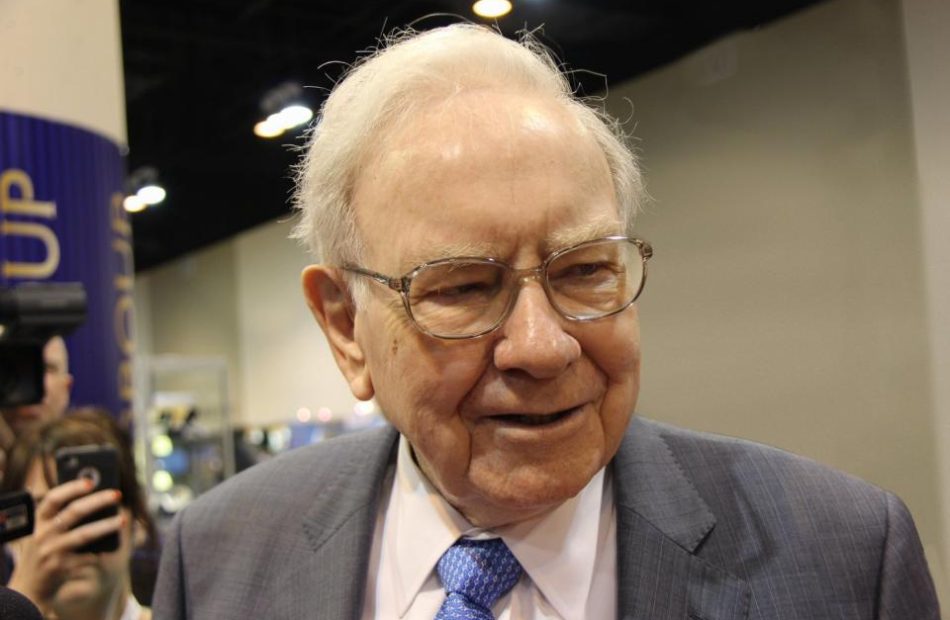38.3% of Warren Buffett's $315 Billion Portfolio Is Invested in 3 Artificial Intelligence (AI) Stocks
Under Warren Buffett’s leadership as CEO, the Berkshire Hathaway (NYSE: BRK.A)(NYSE: BRK.B) investment company has delivered a compound annual return of 19.8% since 1965. That would have been enough to turn an investment of $1,000 back then into a whopping $44.7 million today. By comparison, the same investment in the S&P 500 would have grown to just $338,311 over the same period. That’s why investors closely monitor Berkshire’s every move.
The conglomerate’s success stems from Buffett’s simple investment strategy: He likes companies with steady growth, robust profitability, strong management teams, and shareholder-friendly initiatives like stock buyback programs and dividend schemes. One thing Buffett and his team never do is chase the latest stock market trend, so you won’t find Berkshire piling into red-hot artificial intelligence (AI) stocks.
With that said, three existing stocks in Berkshire’s $315 billion portfolio of publicly listed securities are deploying AI into their legacy businesses in unique ways.
1. Amazon: 0.6% of Berkshire Hathaway’s portfolio
E-commerce is Amazon‘s (NASDAQ: AMZN) core business, but the company is also home to the world’s largest cloud computing platform, Amazon Web Services (AWS). Amazon is using AWS to build a dominant presence across the three core layers of AI:
-
Infrastructure: AWS designed its own data center chips for AI development. One of them is called Trainium, which offers cost savings of up to 50% during the AI training process, compared to infrastructure powered by competing chips like those supplied by Nvidia.
-
Large language models (LLMs): AWS developed a family of LLMs called Titan. Businesses can use them to accelerate the build-out of their own AI software applications. Titan LLMs are available on the Bedrock platform through AWS, along with a selection of other models from third-party AI start-ups like Anthropic.
-
AI software: AWS offers a powerful AI virtual assistant called Q. It’s capable of generating computer code to help developers accelerate their software projects, and businesses can also use it to extract valuable insights from their internal data.
But Amazon is also integrating AI into its e-commerce segment. It developed a virtual assistant called Rufus, which can answer shoppers’ questions and even help them with product comparisons. Plus, Amazon launched Project Private Investigator in its fulfillment centers during the recent second quarter of 2024, which uses AI and computer vision to identify defective products before they are shipped to customers. That could be a huge cost saver over the long term, because it will reduce the number of orders that are returned for a refund.
Berkshire bought Amazon stock in 2019, but Buffett has often expressed regret for failing to identify the opportunity sooner. Still, as long as Berkshire continues to hold the stock, it will likely benefit from Amazon’s fast-growing presence in the AI space.
2. Coca-Cola: 8.9% of Berkshire Hathaway’s portfolio
Coca-Cola (NYSE: KO) is the world’s largest soda company, and it likes to experiment with technology to help improve efficiency, connect with customers, and create new opportunities to generate revenue. The company is now deploying AI in a variety of ways, and it even appointed a “head of generative AI” last year to oversee its efforts.
So far, Coca-Cola has used AI to craft marketing campaigns, and even to design a promotional version of its flagship soda. Coca-Cola Y3000 captures what the drink might taste like in the year 3000 by using AI to analyze mountains of customer data.
But back in April, Coca-Cola made its largest AI commitment to date. It agreed to spend $1.1 billion on Microsoft‘s Azure AI cloud services platform over five years, to help improve workplace productivity, supply chains, marketing, and more.
Berkshire spent $1.3 billion building its stake in Coca-Cola stock between 1987 and 1994, and it has never sold a single share. That position is now worth a whopping $28 billion. Plus, Berkshire is on track to earn $776 million in dividend payments from the beverage giant this year alone.
Although there was no way Buffett could have foreseen the AI revolution back then, his investment conglomerate will reap substantial rewards if this technology drives more revenue and earnings for Coca-Cola.
3. Apple: 28.8% of Berkshire Hathaway’s portfolio
Apple (NASDAQ: AAPL) is the largest company in the world, with a market capitalization of $3.4 trillion. The company is rolling out its Apple Intelligence software, which it developed in partnership with OpenAI to bring AI to the latest generation of iPhones, iPads, and Mac computers.
Apple Intelligence can interpret messages and emails, and draft responses on command. It can also summarize content with a single tap, and prioritize notifications based on what is important to each individual user. Plus, Apple Intelligence will empower the Siri voice assistant with the knowledge and capabilities of OpenAI’s ChatGPT application, which will make it more useful than ever.
Apple Intelligence will utilize Apple’s latest chips, including the A18 Pro (for the iPhone), and the new M4 (for the iPad and Mac computers), which were specifically designed in-house for processing AI workloads. They allow AI features to function on-device, which creates a faster user experience because they don’t have to send requests to external data centers for processing.
Berkshire spent approximately $38 billion buying Apple stock between 2016 and 2023. Earlier this year, that position was worth over $170 billion, which accounted for almost half of the conglomerate’s entire stock portfolio (by value). However, Berkshire sold 13% of its stake during the first quarter, which Buffett said was for tax reasons, and then it sold 49% of its remaining position in the second quarter.
It’s possible the gigantic sales reflect Buffett’s cautious view on the stock market overall, because the S&P 500 index is currently trading at a price-to-earnings ratio of 28.2, which is 55% more expensive than its long-term average of 18.1. Berkshire is now sitting on a record $277 billion in cash, so Buffett and his team might be waiting to pounce in the event of a market correction.
Nevertheless, Apple remains Berkshire’s largest holding, so the conglomerate will still benefit nicely if Apple Intelligence pushes consumers to upgrade to the latest devices to access its features.
Don’t miss this second chance at a potentially lucrative opportunity
Ever feel like you missed the boat in buying the most successful stocks? Then you’ll want to hear this.
On rare occasions, our expert team of analysts issues a “Double Down” stock recommendation for companies that they think are about to pop. If you’re worried you’ve already missed your chance to invest, now is the best time to buy before it’s too late. And the numbers speak for themselves:
-
Amazon: if you invested $1,000 when we doubled down in 2010, you’d have $20,363!*
-
Apple: if you invested $1,000 when we doubled down in 2008, you’d have $41,938!*
-
Netflix: if you invested $1,000 when we doubled down in 2004, you’d have $378,539!*
Right now, we’re issuing “Double Down” alerts for three incredible companies, and there may not be another chance like this anytime soon.
*Stock Advisor returns as of October 7, 2024
John Mackey, former CEO of Whole Foods Market, an Amazon subsidiary, is a member of The Motley Fool’s board of directors. Anthony Di Pizio has no position in any of the stocks mentioned. The Motley Fool has positions in and recommends Amazon, Apple, Berkshire Hathaway, Microsoft, and Nvidia. The Motley Fool recommends the following options: long January 2026 $395 calls on Microsoft and short January 2026 $405 calls on Microsoft. The Motley Fool has a disclosure policy.
38.3% of Warren Buffett’s $315 Billion Portfolio Is Invested in 3 Artificial Intelligence (AI) Stocks was originally published by The Motley Fool
Automotive Actuators Market Size Expected to Hit USD 33.7 Billion by 2034, Growing at 4.4% CAGR as Demand for Enhanced Vehicle Efficiency Rises – Report by Transparency Market Research Inc.
Wilmington, Delaware, United States, Transparency Market Research, Inc. , Oct. 09, 2024 (GLOBE NEWSWIRE) — The global automotive actuators market (자동차 액추에이터 시장) is estimated to surge at a CAGR of 4.4% from 2024 to 2034. Transparency Market Research projects that the overall sales revenue for automotive actuators is estimated to reach US$ 33.7 billion by the end of 2034.
Some prominent players are as follows:
- ABB Ltd.
- Actuonix Motion Devices
- Actus Manufacturing Inc.
- BorgWarner Inc.
- Continental AG
- CTS Corporation
- Denso Corporation
- EFI Automotive
- Hells GmbH & Co. KGaA
- Hitachi Automotive System Ltd.
- Johnson Electric
- Mahle GmbH
- Marelli Corporation
- Mitsubishi Electric Corporation
Get Sample PDF Brochure from Here: https://www.transparencymarketresearch.com/sample/sample.php?flag=S&rep_id=86013

A key driver is the rising demand for actuators in automotive interiors, driven by the increasing integration of comfort and convenience features. Actuators play a crucial role in controlling functions such as seat adjustments, HVAC vents, and interior lighting, enhancing passenger comfort and user experience.
The adoption of advanced materials such as shape memory alloys (SMAs) and smart polymers is revolutionizing actuator design and performance. These materials offer unique properties such as shape memory effect, self-healing capabilities, and adaptive response to stimuli, enabling actuators to achieve unprecedented levels of precision and efficiency in vehicle applications.
The emergence of distributed actuation systems, leveraging decentralized control and modular design principles, presents opportunities for enhanced flexibility and scalability in automotive actuator solutions. By distributing actuation functions across multiple actuators and subsystems, automotive manufacturers can optimize performance, reliability, and cost-effectiveness in vehicle platforms.
Key Findings of the Market Report
- HVAC actuators lead the automotive actuators market, driven by demand for climate control systems in vehicles for passenger comfort.
- Electromechanical actuators lead the automotive actuators market, driven by their precision, efficiency, and compatibility with advanced automotive technologies.
- Shape memory alloy (SMA) emerges as the leading material segment in the automotive actuators market due to its superior performance and durability.
Automotive Actuators Market Growth Drivers & Trends
- Increasing adoption of electric vehicles (EVs) and advanced driver assistance systems (ADAS) drives demand for automotive actuators.
- Technological advancements enable actuators to enhance vehicle performance, efficiency, and safety.
- Growing focus on sustainability and emission reduction fuels demand for electric actuators.
- Integration of actuators in autonomous vehicles and connected cars revolutionizes automotive mobility.
- Shift towards lightweight materials and compact designs in actuators enhance fuel efficiency and reduces carbon footprint.
Unlock Growth Potential in Your Industry! Download PDF Brochure: https://www.transparencymarketresearch.com/sample/sample.php?flag=S&rep_id=86013
Global Automotive Actuators Market: Regional Profile
- North America, home to established automotive manufacturers and tech giants, leads in technological innovation and adoption. Companies like Delphi Technologies and BorgWarner Inc. drive the region’s actuator market with a focus on electric vehicles (EVs) and advanced driver assistance systems (ADAS). Stringent emissions regulations and consumer demand for fuel-efficient vehicles propel the market forward.
- In Europe, a stronghold of automotive engineering excellence, companies such as Continental AG and Valeo SA dominate the landscape with a focus on sustainability and connectivity. Europe’s emphasis on reducing carbon footprint and enhancing vehicle safety fosters the adoption of electric actuators and intelligent control systems.
- Asia Pacific emerges as a manufacturing powerhouse and a burgeoning market for automotive actuators. Companies like Hitachi Automotive Systems Ltd. and Denso Corporation lead the charge, capitalizing on the region’s growing automotive production and demand for affordable, efficient vehicles. Government initiatives promoting electric mobility and smart transportation solutions further drive market growth in Asia Pacific.
Automotive Actuators Market: Competitive Landscape
In the competitive landscape of the automotive actuators market, key players vie for market share through innovation and strategic partnerships. Companies like Continental AG, Robert Bosch GmbH, and Denso Corporation dominate with a wide range of advanced actuator solutions, catering to the evolving needs of the automotive industry.
Emerging players such as Magna International Inc. and Hitachi Automotive Systems Ltd. are gaining traction with their focus on electric and autonomous vehicle technologies. Intense competition drives continuous advancements in actuator efficiency, reliability, and integration, enabling automakers to enhance vehicle performance, safety, and comfort in an ever-evolving automotive landscape.
Product Portfolio
- ABB Ltd. offers a comprehensive portfolio of innovative automation and electrification solutions. From industrial robots to power grids, ABB’s cutting-edge technologies drive efficiency, reliability, and sustainability across various industries, empowering customers to achieve their goals with precision and confidence.
- Actuonix Motion Devices specializes in compact and precise linear motion solutions. With a focus on miniaturization and performance, Actuonix’s actuators and linear motion products cater to diverse applications, from robotics and automation to aerospace and medical devices.
- Actus Manufacturing Inc. delivers high-quality precision machining and manufacturing services. With state-of-the-art facilities and a team of skilled professionals, Actus offers customized solutions for aerospace, automotive, and defense industries, ensuring superior quality and reliability in every product.
Automotive Actuators Market: Key Segments
By Product Type
- Brake Actuators
- Cooling Valve Actuators
- EGR Actuators
- Grill Shutter Actuators
- Headlamp Actuators
- HVAC Actuators
- Power Seat Actuators
- Steering Column Adjustment Actuators
- Sunroof Actuators
- Tailgate Actuators
- Throttle Actuators
- Turbo Actuators
- Telescopic Nozzle Actuators
- Piezoelectric Actuators
- Door Lock Actuators
- Others
By Actuation Type
- Pneumatic
- Hydraulic
- Electromechanical
By Type of Motion
By Material
- Shape Memory Alloy (SMA)
- Smart Polymers
- Others
By Application
- Engine
- Body Control & Exterior
- Interior
- E-powertrain
- Others
By Propulsion Type
- Battery Electric Vehicles
- Hybrid/ Plug-in Hybrid Electric Vehicles
- Fuel Cell Electric Vehicles
By Vehicle Type
- Two Wheelers
- Three Wheelers
- Passenger Vehicles
- Light Commercial Vehicles
- Heavy Duty Trucks
- Buses & Coaches
- Off-road Vehicles
- Agriculture Tractors & Equipment
- Construction & Mining Equipment
By Sales Channel
By Region
- North America
- Europe
- Asia Pacific
- South America
- Middle East & Africa
Buy this Premium Research Report: https://www.transparencymarketresearch.com/checkout.php?rep_id=86013<ype=S
More Trending Reports by Transparency Market Research –
- Vehicle Subscription Market– The vehicle subscription market (차량 구독 시장) was valued at US$ 4.9 Bn in 2021 and it is estimated to grow at a CAGR of 21.1% from 2022 to 2031.
- Luxury Yacht Charter Market– The global luxury yacht charter industry (호화 요트 전세 산업) is projected to advance at a CAGR of 4.1% between 2022 and 2031 to reach more than US$ 19.0 Billion by the end of 2031.
- Vehicle-to-Everything (V2X) Communications Market – The vehicle-to-everything (v2x) communications market (V2X(Vehicle-to-Everything) 통신 시장) is estimated to grow at a CAGR of 5.3% from 2024 to 2034.
- ASEAN Second Hand Truck Market – The ASEAN second hand truck market (중고 트럭 시장) is estimated to advance at a CAGR of 27.4% from 2024 to 2034.
About Transparency Market Research
Transparency Market Research, a global market research company registered at Wilmington, Delaware, United States, provides custom research and consulting services. Our exclusive blend of quantitative forecasting and trends analysis provides forward-looking insights for thousands of decision makers. Our experienced team of Analysts, Researchers, and Consultants use proprietary data sources and various tools & techniques to gather and analyses information.
Our data repository is continuously updated and revised by a team of research experts, so that it always reflects the latest trends and information. With a broad research and analysis capability, Transparency Market Research employs rigorous primary and secondary research techniques in developing distinctive data sets and research material for business reports.
Contact:
Transparency Market Research Inc.
CORPORATE HEADQUARTER DOWNTOWN,
1000 N. West Street,
Suite 1200, Wilmington, Delaware 19801 USA
Tel: +1-518-618-1030
USA – Canada Toll Free: 866-552-3453
Website: https://www.transparencymarketresearch.com
Email: sales@transparencymarketresearch.com
Follow Us: LinkedIn| Twitter| Blog | YouTube

© 2024 Benzinga.com. Benzinga does not provide investment advice. All rights reserved.
Trump's Teen Granddaughter Poses With Cybertruck For Homecoming Weekend As Tesla CEO Elon Musk And Former President's Ties Deepen
Former President Donald Trump‘s 17-year-old granddaughter Kai Trump posed with a Cybertruck for her high school homecoming celebration on Instagram as ties between Tesla Inc. CEO Elon Musk and Trump deepen.
What Happened: “Homecoming weekend,” Kai Trump wrote while sharing pictures with the stainless steel vehicle. While one of the pictures shows Kai driving the truck, another shows her posing in front of the vehicle with friends.

“Cool,” Musk wrote on social media platform X about Kai’s photos with the truck.
Why It Matters: Musk officially endorsed Trump in July after a shooting incident at a rally in Pennsylvania. The billionaire also attended a Trump campaign event in Pennsylvania earlier this month and termed the election a “must-win situation” for Trump.
The CEO is planning more campaigning for Trump in the state, Reuters reported on Monday, citing a source familiar with the effort.
Trump, meanwhile, has expressed his intent to set up a government efficiency commission led by Musk if elected President. The commission will be tasked with conducting a complete financial and performance audit of the federal government and recommending reforms, Trump said in September.
Check out more of Benzinga’s Future Of Mobility coverage by following this link.
Read More:
Photo courtesy: Shutterstock
Market News and Data brought to you by Benzinga APIs
© 2024 Benzinga.com. Benzinga does not provide investment advice. All rights reserved.
RESAAS Announces Extension of Warrants
VANCOUVER, BC, Oct. 8, 2024 /CNW/ – RESAAS Services Inc. (“RESAAS”) RSS RSASF, a leading provider of technology solutions for the real estate industry, today announced that it is intending to extend the expiry date of an aggregate 2,075,000 outstanding common share purchase warrants (the “Warrants”) due to expire on October 17, 2024.
The Warrants were issued in connection with an over-subscribed private placement transaction that closed on October 17, 2023 and are exercisable at $0.60 per common share.
Under the proposed amendment to the Warrants (the “Proposed Amendment”), the Company proposes to extend the expiry date for a further one year to October 17, 2025 (the “Warrant Extension”), with all other terms of the Warrants remaining the same. The Proposed Amendment is subject to approval by the TSX Venture Exchange.
About RESAAS Services Inc.
RESAAS is an award-winning technology company serving the Real Estate Industry, uniting all Real Estate Brokerages and Agencies in one Global, Centralized Industry Platform.
Over 600,000 RESAAS Agents in 160 countries have access to unique Real Estate Data, providing access to qualified international referrals and Coming Soon listings only available inside RESAAS.
Some of Real Estate’s largest organizations leverage RESAAS to provide Business Intelligence, new business opportunities, and real-time industry-wide communication. For more information, please visit www.resaas.com.
Disclaimer
The TSX Venture Exchange has neither approved nor disapproved the contents of this news release. Neither the TSX Venture Exchange nor its Regulation Services Provider (as that term defined in the policies of the TSX Venture Exchange) accepts responsibility for the adequacy or accuracy of this release.
The statements made in this news release may contain forward-looking statements that may involve a number of risks and uncertainties. Actual events or results could differ materially from RESAAS Services Inc.’s expectations and projections.
SOURCE RESAAS Services Inc.

![]() View original content: http://www.newswire.ca/en/releases/archive/October2024/08/c5438.html
View original content: http://www.newswire.ca/en/releases/archive/October2024/08/c5438.html
Market News and Data brought to you by Benzinga APIs
© 2024 Benzinga.com. Benzinga does not provide investment advice. All rights reserved.
Commercial insurance market projects stability as rates moderate across most lines of business
NEW YORK, Oct. 09, 2024 (GLOBE NEWSWIRE) — According to the latest Insurance Marketplace Realities report from WTW ((Willis Towers Watson, NASDAQ:WTW), a leading global advisory, broking and solutions company, commercial insurance rates have demonstrated balance and stability throughout the year across North America. Jon Drummond, Head of Broking, North America, WTW, commented, “The industry has not categorically rewritten its position on any one line of business, but rather has taken micro-actions reacting to emerging trends.”
WTW reports that new capital in both the reinsurance and retail marketplace has led to increased competition for premium market share, excluding umbrella and excess liability. This trend has played out across the industry, which is particularly meaningful in 1st party business where capacity was a challenge at the outset of 2024.
Capacity remains a driving force in delivering soft market conditions for financial lines. While WTW advises that it may be premature to call it a trend, there appears to be mounting focus on rate adequacy in mid-excess Directors & Officers Liability. In addition, the Cyber market projects flat to mid-single digit rate decreases across most renewals in the near term.
In casualty, Umbrella & Excess liability has seen the most amount of disruption. Loss costs continue to rise due to factors including legal system abuse, litigation financing, and the growth of concerns such as forever chemicals, to which the insurance market has responded by reducing lines of capacity available to insureds and pushing renewal rates past high single-digit.
WTW’s Marketplace Realities report concludes that while the industry is facing evolutionary change across many lines of business – e.g. climate change, nuclear verdicts, new capital entrants, etc. – the market should deliver relatively stable renewal conditions across most lines of business as the year comes to a close.
Drummond added, “It goes without saying that the current state of affairs might only be one major hurricane away from being upended, and with Milton knocking on the door, the probability of disruption is growing.”
Key Price Predictions for 2024
| Property | |
| CAT-exposed | -5% to +10% |
| Non-CAT exposed | -5% to +5% |
| Domestic casualty | |
| General liability | +2% to +8% |
| Umbrella (high hazard) | +8% to +15% |
| Excess (high hazard) | +10% + |
| Excess (low hazard) | +2% to +7% |
| Workers’ compensation | -5% to +2% |
| Auto | +4% to +10% |
| International | Flat |
| Executive risks | |
| Directors’ and officers’ public company (primary) | -10% to Flat |
| Directors’ and officers’ private / not-for-profit (overall) | -10% to Flat |
| Side A / DIC | -10% to Flat |
| Errors and omissions (large law firms) | +2% to +8% |
| Employment practices liability (primary) | -5% to +5% |
| Fiduciary (financial institutions) | -5% to +5% |
| Cyber | |
| Cyber | -5% to Flat |
| Political risk | |
| Most risks | Flat to +20% |
| Terrorism and political violence | |
| Terrorism and sabotage | Flat to +10% Non-volatile territories +10% to +25% Volatile territories |
| Political violence | Flat to +15% Non-volatile territories +15% to +30% Volatile territories |
About WTW
At WTW WTW, we provide data-driven, insight-led solutions in the areas of people, risk and capital. Leveraging the global view and local expertise of our colleagues serving 140 countries and markets, we help organizations sharpen their strategy, enhance organizational resilience, motivate their workforce and maximize performance.
Working shoulder to shoulder with our clients, we uncover opportunities for sustainable success—and provide perspective that moves you. Learn more at wtwco.com.
Media Contacts
Douglas Menelly, Public Relations Lead, North America
Douglas.Menelly@wtwco.com | +1 (516) 972 0380
Arnelle Sullivan, Public Relations Associate, North America
Arnelle.Sullivan@wtwco.com | +1 (718) 208-0474

Market News and Data brought to you by Benzinga APIs
© 2024 Benzinga.com. Benzinga does not provide investment advice. All rights reserved.
Wall Street's Newest Stock-Split Stock Has Arrived — and Here's the Magnificent Stock Likely to Follow in Its Footsteps
For almost two years, artificial intelligence (AI) has been the top trend powering Wall Street’s major stock indexes higher. But over the last nine months, excitement surrounding stock splits has played an equally important role in boosting the value of select market-leading companies.
A stock split gives publicly traded companies the option of superficially adjusting their share price and outstanding share count by the same magnitude. These changes are surface-scratching in the sense that they have no impact on a company’s market cap or operating performance.
Since retail juggernaut Walmart kicked off stock-split euphoria in late January, north of a dozen prominent businesses have announced or completed a split. All but one of these are of the forward-split variety, which is designed to make shares more nominally affordable for retail investors who lack access to fractional-share purchases through their broker.
Today, Oct. 9, marks the arrival of Wall Street’s newest stock split, as well as paves the way for another market-leading business to potentially follow in its footsteps.
Wall Street’s newest stock-split stock is ready to shine
Nearly five months ago, in mid-May, Japan-based consumer electronics colossus Sony Group (NYSE: SONY) revealed plans to conduct a 5-for-1 forward split. Although the effective date for this split was Oct. 1 in Japan, it was a week later (Oct. 8) for its American depositary receipts (ADRs) listed in the U.S. When trading commences today, Sony’s stock should be close to $19 per share, down from $95 per share, where it began the week.
Sony is best-known for its gaming prowess. The company’s PlayStation 5 (PS5) is the top-selling ninth-generation gaming console. Although the PS5 has been on retail shelves for almost four years, Sony recently announced plans to increase the price of its top-selling console by 19% in Japan. On top of raising additional revenue, this demonstrates just how commanding of a position Sony holds in the gaming arena.
Furthermore, revenue for the company’s PlayStation Plus subscription has been climbing. PlayStation Plus is the multitiered subscription service that allows users to save their gaming data in the cloud, game with their friends, and access exclusive gaming titles. This considerably higher-margin segment is perhaps the best way for Sony to counter the staleness of having its PS5 in stores for nearly four years.
Based on what history tells us, Sony’s next-generation console should be available in two to three years. It wouldn’t be a surprise to see Sony’s stock rally in advance of this release.
But as I pointed out earlier this week, Sony Group is about more than just gaming. Its Imaging and Sensing Solutions (ISS) segment is currently growing by double digits. What’s powering this growth in ISS is strong demand for the company’s image sensors, which are used in smartphones. Wireless carriers upgrading and expanding the coverage of their networks to support 5G download speeds have encouraged consumers to upgrade their wireless devices.
Sony also has a shareholder-friendly capital-return program. As of Sept. 30, it had completed the repurchase of 14.67 million shares of its common stock for 194.5 billion yen, which equates to roughly $131.5 million U.S. For companies with steady or growing net income, such as Sony, share repurchases can improve earnings per share and make their stock more attractive to investors.
The $64,000 question is: Which company is set to follow in Sony’s footsteps and become Wall Street’s next stock-split stock?
This generational business might be Wall Street’s next stock-split stock
While there are quite a few standout businesses that appear ripe for a stock split, including warehouse club Costco Wholesale, software company Adobe, and pharmaceutical giant Eli Lilly, the one that may be the likeliest to walk in Sony’s footsteps and announce a split is social media leader Meta Platforms (NASDAQ: META).
Interestingly enough, Meta is the only member of the “Magnificent Seven” to have never completed a stock split. But with its shares topping $600 on an intra-day basis to open this week, there’s a clear reason to make its stock more nominally affordable for everyday investors.
Meta is best-known as the parent of leading social media destinations Facebook, WhatsApp, Instagram, and Facebook Messenger, among other sites. During the June-ended quarter, Meta attracted 3.27 billion people to its apps on a daily basis. No social media company comes remotely close to luring this many daily active users (DAUs).
The advantage of having more than 3.2 billion DAUs is that advertisers will often pay a premium to get their message(s) in front of consumers. Since economic expansions last considerably longer, on average, than recessions, an ad-driven operating model like Meta is usually able to command exceptionally strong ad-pricing power.
But Meta is also gearing up for a future that should feature sustained double-digit growth potential. It’s aggressively investing in its AI ambitions by spending in the neighborhood of $10.5 billion to purchase 350,000 AI-graphics processing units (GPUs) from Nvidia. These chips will power Meta’s AI-accelerated data centers.
Meanwhile, the company’s money-losing Reality Labs segment is building on CEO Mark Zuckerberg’s metaverse vision behind the scenes. Meta is positioning itself to be a key on-ramp to the metaverse, although it could take years before the company’s investments yields meaningful revenue.
To add, Meta Platforms is sitting on a truly enviable amount of cash. It closed out the midpoint of 2024 with $58.1 billion in cash, cash equivalents, and marketable securities, and is pacing north of $77 billion in net cash generated from its operations for the current year. Meta’s balance sheet affords it the luxury of taking risks.
Perhaps no company is primed to become Wall Street’s next stock-split stock more than Meta Platforms.
Should you invest $1,000 in Sony Group right now?
Before you buy stock in Sony Group, consider this:
The Motley Fool Stock Advisor analyst team just identified what they believe are the 10 best stocks for investors to buy now… and Sony Group wasn’t one of them. The 10 stocks that made the cut could produce monster returns in the coming years.
Consider when Nvidia made this list on April 15, 2005… if you invested $1,000 at the time of our recommendation, you’d have $782,682!*
Stock Advisor provides investors with an easy-to-follow blueprint for success, including guidance on building a portfolio, regular updates from analysts, and two new stock picks each month. The Stock Advisor service has more than quadrupled the return of S&P 500 since 2002*.
*Stock Advisor returns as of October 7, 2024
Randi Zuckerberg, a former director of market development and spokeswoman for Facebook and sister to Meta Platforms CEO Mark Zuckerberg, is a member of The Motley Fool’s board of directors. Sean Williams has positions in Meta Platforms. The Motley Fool has positions in and recommends Adobe, Costco Wholesale, Meta Platforms, Nvidia, and Walmart. The Motley Fool has a disclosure policy.
Wall Street’s Newest Stock-Split Stock Has Arrived — and Here’s the Magnificent Stock Likely to Follow in Its Footsteps was originally published by The Motley Fool
These Are the 3 Fastest-Growing Artificial Intelligence (AI) Stocks
There are many ways to define “the fastest-growing” stocks. You can focus on market returns, sales growth, or profits, and you can look at proven results or future expectations. Traditionalists may prefer analyzing reported results and historical market data. Growth-oriented investors can lean into forward-looking projections, based on rapid top-line growth or beefy long-term profit targets.
Today, I’m looking at the fastest-growing artificial intelligence (AI) stocks of the last three years, in terms of estimated revenue growth. This way, I’ll zoom in on companies with plenty of business growth expected in the years ahead, no matter what they did in the early days of the generative AI boom.
So here are the top three names of that analysis, based on their top-line sales’ expected compound annual growth rate (CAGR) in the next three years.
1. Nvidia: 50.4% estimated CAGR
It’s no secret that semiconductor designer Nvidia (NASDAQ: NVDA) has grown like wildfire in recent years. Its trailing 3-year revenue growth stands at a spine-chilling CAGR of 63.8% at the moment. OpenAI introduced its groundbreaking ChatGPT system in November 2022. As the primary provider of AI accelerator hardware for that platform, Nvidia has enjoyed skyrocketing sales ever since.
And analysts see no end to that trend. Your average analyst firm expect Nvidia to deliver annual sales growth of roughly 50.4% over the next three years.
I agree that Nvidia should deliver strong sales growth in this AI boom. However, it gets harder and harder to maintain these skyrocketing growth rates as the base figure for each year-over-year comparison increases. Moreover, I’m not convinced that the analyst community gives enough respect to Nvidia’s current and potential rivals. If nothing else, having plenty of high-powered AI accelerator chips available could limit Nvidia’s gross profit margins over time.
So Nvidia looks overpriced to me, since Wall Street’s growth targets seem a bit too optimistic. I cashed in some of my paper gains on this stock several months ago. Yet, the analysts might be right. I’d be kicking myself if Nvidia continues to dominate the AI hardware space and my portfolio had no connection to that opportunity. You should check your risk tolerance before backing away from Nvidia’s soaring stock — or doubling down on it.
2. Super Micro Computers: 36% estimated CAGR
Nvidia is the leading seller of AI accelerator chips, and Super Micro Computers (NASDAQ: SMCI) sells a ton of custom server systems using those chips. As a result, Supermicro’s sales growth is trailing slightly behind Nvidia’s. In an alternate universe where this was the only builder of AI servers, Supermicro could have shown growth equal to or even greater than Nvidia’s.
In this world, Supermicro started this surge from a much lower revenue level than Nvidia, as is currently raising its long-term growth rate faster. Supermicro stands out in the system-building market with a combination of unique cooling solutions and relatively low system prices.
That being said, Supermicro’s target market is even more fragmented than Nvidia’s. Hewlett Packard Enterprise (NYSE: HPE) and Dell (NYSE: DELL) sell far more servers than Supermicro, even in the AI server niche. On the upside, this situation gives Supermicro more room to take market share from rivals, outgrowing its peers in the process. On the downside, the HPs and Dells out there won’t simply stand back and let Supermicro win.
So this is another challenging growth target. At the same time, Supermicro comes with lofty valuation ratios for this subsector. As such, it’s far from my favorite buying idea among AI stocks.
3. Cloudflare: 27.7% estimated CAGR
Finally, network security and performance specialist Cloudflare (NYSE: NET) trails behind Supermicro’s revenue growth due to a significant slowdown in the last two years.
Cloudflare isn’t a pure-play AI investment, but the company has strong ties to the emerging AI space. You can already buy AI-oriented edge computing services directly from Cloudflare, using its global network of servers and AI accelerators to deliver results near the end user. Its cybersecurity and network acceleration features are also quite valuable for AI service providers. For example, ChatGPT’s services always pass through Cloudflare’s content delivery and data security tools.
So Cloudflare is a serious AI investment with robust revenue growth. The company is also boosting its AI computing infrastructure over time. Meanwhile, Cloudflare recently revamped its sales department, boosting both its revenue growth per sales agent and operating margin.
The stock is far from cheap, but Cloudflare is perhaps the most convincing long-term growth story on this list. This company is pulling several levers to keep the growth fires burning, and the best chapters of Cloudflare’s story may still be unwritten.
Should you invest $1,000 in Cloudflare right now?
Before you buy stock in Cloudflare, consider this:
The Motley Fool Stock Advisor analyst team just identified what they believe are the 10 best stocks for investors to buy now… and Cloudflare wasn’t one of them. The 10 stocks that made the cut could produce monster returns in the coming years.
Consider when Nvidia made this list on April 15, 2005… if you invested $1,000 at the time of our recommendation, you’d have $782,682!*
Stock Advisor provides investors with an easy-to-follow blueprint for success, including guidance on building a portfolio, regular updates from analysts, and two new stock picks each month. The Stock Advisor service has more than quadrupled the return of S&P 500 since 2002*.
*Stock Advisor returns as of October 7, 2024
Anders Bylund has positions in Nvidia. The Motley Fool has positions in and recommends Cloudflare and Nvidia. The Motley Fool has a disclosure policy.
These Are the 3 Fastest-Growing Artificial Intelligence (AI) Stocks was originally published by The Motley Fool
2 Dividend Stocks to Double Up on Right Now
Investing in stocks of strong companies that offer unusually high yields relative to their dividend-paying history can help you populate your portfolio with winners. Here are two dividend stocks that are paying their highest yield in years. You might want to give them added consideration. Here’s why.
1. Nike
Right now, investors have the opportunity to buy shares of one of the most iconic brands in the world while they trade at a discount. Sports apparel conglomerate Nike (NYSE: NKE) generates $50 billion in annual revenue making it, among other things, the global leader in footwear. But Nike’s stock price has fallen 54% from its previous peak over weak consumer spending. The lower share price pushed Nike’s forward dividend yield up to an above-average 1.83% based on a current quarterly per-share payout of $0.37 — the highest yield since 2009.
It’s a challenging year for Nike. Sales fell by double-digit rates year-over-year in the most recent quarter. However, Nike continues to remain profitable while management implements a new strategy to turn sales around. Its current quarterly dividend is about half its quarterly earnings, which gives the company a cushion to sustain dividends even during a challenging retail environment.
Nike recently hired former company veteran Elliott Hill as its new CEO. The hire has the company’s teams upbeat about the future, which is a great sign. While a return to growth is expected to take some time, Hill’s experience in leading the company’s commercial and marketing operations for Nike and Jordan Brand across four geographies should be valuable in engineering a turnaround.
Nike is in the process of shifting its product portfolio away from lifestyle products to a focus on sports, which is the heart of the brand. The company has already seen early progress, with growth across men’s fitness, global football, and running footwear in the fiscal first quarter of 2025.
With the global athletic wear market expected to keep growing to $293 billion by 2029, according to Statista, investing in Nike should pay off with good returns and many years of passive income.
2. Verizon Communications
The leading telecom operators make great dividend investments thanks to their recurring revenue streams from wireless and broadband subscribers. Verizon Communications (NYSE: VZ) reported healthy increases in postpaid phone net additions recently that sent the stock up 16% this year, but the shares still offer a high forward dividend yield of 6.16% — Verizon’s highest yield in over a decade.
The concerns Wall Street had about telecom growth amid the macroeconomic challenges this year were muted last quarter. Verizon reported a solid 12% year-over-year increase in consumer postpaid phone net additions, which refers to those customers who pay for their wireless plan with a monthly charge. Verizon could be well positioned to ride the coattails of Apple as it launches new artificial intelligence (AI)-optimized iPhones that are expected to drive strong sales.
The secret to Verizon’s growth strategy is that it offers attractive add-on services to win customers to its wireless service, including deals on subscriptions to top digital entertainment services. These compelling add-ons will be valuable tools in retaining customers and driving strong financial results to support the dividend.
Verizon has paid a dividend every year for 40 years, including all the companies that were merged over the years to create what is today Verizon Communications. The current per-share quarterly dividend is $0.6775, representing a payout ratio of 60% based on adjusted earnings guidance for 2024. With strong demand expected for AI-enabled smartphones over the next several years, buying Verizon shares at their current high yield should lead to excellent returns for investors.
Should you invest $1,000 in Nike right now?
Before you buy stock in Nike, consider this:
The Motley Fool Stock Advisor analyst team just identified what they believe are the 10 best stocks for investors to buy now… and Nike wasn’t one of them. The 10 stocks that made the cut could produce monster returns in the coming years.
Consider when Nvidia made this list on April 15, 2005… if you invested $1,000 at the time of our recommendation, you’d have $782,682!*
Stock Advisor provides investors with an easy-to-follow blueprint for success, including guidance on building a portfolio, regular updates from analysts, and two new stock picks each month. The Stock Advisor service has more than quadrupled the return of S&P 500 since 2002*.
*Stock Advisor returns as of October 7, 2024
John Ballard has no position in any of the stocks mentioned. The Motley Fool has positions in and recommends Apple and Nike. The Motley Fool recommends Verizon Communications. The Motley Fool has a disclosure policy.
2 Dividend Stocks to Double Up on Right Now was originally published by The Motley Fool
Automotive Glow Plugs Market Size to Hit USD 4.69 Billion by 2033 | Straits Research
New York, United States, Oct. 08, 2024 (GLOBE NEWSWIRE) — In order to start the diesel engine in cars, glow plugs are tiny heating elements. A glow plug warms the mixture of air and fuel before lighting the car engine. Each diesel engine cylinder block has a heating system element installed to warm the fuel and air mixture as it enters the engine to ensure efficient combustion when the engine is cold. A glow plug comprises several additional components, such as insulation powder, a heating coil, a regulating coil, a center electrode, and a terminal nut.
Download Free Sample Report PDF @ https://straitsresearch.com/report/automotive-glow-plugs-market/request-sample
Market Dynamics
High Demand for Commercial Vehicles Drives the Global Market
Commercial vehicles are in high demand globally, and fleet expansion and renewal initiatives are gaining traction due to high-capacity utilization and profitability. Fleet renewals and expansions have been accelerated by the favorable macroeconomic environment and crucial operator profitability. Pickup truck demand has grown over the past few years due to consumers’ increasing preference for multipurpose utility and superior comforts, especially in North America and Europe.
Additionally, mounting environmental concerns are pressuring the governing bodies to take action to reduce emissions from commercial vehicles. Glow plugs, which promote efficient fuel combustion and raise vehicle fuel efficiency, are expected to increase demand. Therefore, it is anticipated that the commercial vehicle segment of the market will grow more quickly than other segments during the forecast period.
Development of DIY Parts and Growing E-commerce Platforms Creates Tremendous Opportunities
The modern consumer wants to read reviews, compare prices, and conduct product research before purchasing. Manufacturers and distributors of parts are therefore compelled to adhere to these requirements. Sales of auto parts are increasing globally as more consumers favor DIY products. Locals quickly stop shopping at traditional brick-and-mortar stores in favor of online platforms because of their convenience. Additionally, there is a greater demand for DIY parts and components in the United States and Europe than in the Asia-Pacific, Latin America, and the Middle East. The aftermarket players’ creation of DIY parts and e-commerce platforms will present a promising market opportunity during the forecast period.
Regional Analysis
Asia-Pacific is the most significant global automotive glow plugs market shareholder and is expected to grow at a CAGR of 4.12% during the forecast period. The market is anticipated to be primarily driven by increasing commercial vehicle production and sales during the forecast period. Glow plug demand from passenger cars will remain muted over the forecast period because most new cars sold in China are gasoline-powered. The market is concerned about how quickly the country is electrifying its automobiles. However, it is anticipated that demand from the aftermarket and demand from the export of vehicles will fuel the market growth during the anticipated period.
Europe is expected to grow at a CAGR of 4.11%, generating USD 1.69 billion during the forecast period. Diesel vehicles are extremely popular, especially in the four-wheel drive, compact, minivan, and small SUV segments of passenger cars and light commercial vehicles. In Spain (in 2019), approximately 201,929 four-wheel-drive vehicles and 75,392 compact vehicles with internal combustion diesel engines were sold. It is anticipated that this demand for diesel-powered vehicles in some passenger car segments will continue during the forecast period, supporting the need for OEM glow plugs.
North America is expected to grow significantly over the forecast period. The release of new SUVs and an increase in the replacement of worn-out commercial vehicles are expected to increase demand for new cars during the forecast period, which will, in turn, fuel the market. Due to the widespread use of commercial vehicles across the country, it is also anticipated that demand for aftermarket automotive glow plugs will rise during the forecast period.
To Gather Additional Insights on the Regional Analysis of the Automotive Glow Plugs Market @ https://straitsresearch.com/report/automotive-glow-plugs-market/request-sample
Key Highlights
- Based on product type, the global automotive glow plugs market is bifurcated into metal and ceramic glow plugs. The metal glow plug segment is the highest contributor to the market and is expected to grow at a CAGR of 4.09% during the forecast period.
- Based on vehicle type, the global automotive glow plugs market is bifurcated into passenger cars and commercial vehicles. The commercial vehicles segment owns the highest market share and is expected to grow at a CAGR of 4.39% during the forecast period.
- Based on sales channels, the global automotive glow plugs market is bifurcated into OEM and aftermarket. The aftermarket segment is the highest contributor to the market and is expected to grow at a CAGR of 4.43% during the forecast period.
- Asia-Pacific is the most significant global automotive glow plugs market shareholder and is expected to grow at a CAGR of 4.12% during the forecast period.
Competitive Players
- Denso Corporation
- NGK Spark Plug Co. Ltd
- Robert Bosch GmbH
- BorgWarner Inc.
- Autolite (Fram Group LLC)
- Tenneco Inc.
- ACDelco Corporation
- KLG Spark Plugs
- Wellman Glow Plugs Co. (WAP Inc.)
Recent Developments
- October 2022- The Board of Directors of GK SPARK PLUG CO., LTD. decided to finalize the Joint Venture Agreement (“JVA”) regarding capital and business alliance with IMC International Metalworking Companies B.V. by converting the Company’s consolidated subsidiary into the joint venture company.
- October 2022- Autolite announced its support of the Techforce Mobile Stem Career Center at Aapex 2022.
Segmentation
- By Product Type
- Metal Glow Plug
- Ceramic Glow Plug
- By Vehicle Type
- Passenger Cars
- Commercial Vehicles
- By Sales Channel
- OEM
- Aftermarket
- By Region
- North America
- Europe
- Asia Pacific
- Middle East And Africa
- Latin America
Get Detailed Market Segmentation @ https://straitsresearch.com/report/automotive-glow-plugs-market/segmentation
About Straits Research Pvt. Ltd.
Straits Research is a market intelligence company providing global business information reports and services. Our exclusive blend of quantitative forecasting and trends analysis provides forward-looking insight for thousands of decision-makers. Straits Research Pvt. Ltd. provides actionable market research data, especially designed and presented for decision making and ROI.
Whether you are looking at business sectors in the next town or crosswise over continents, we understand the significance of being acquainted with the client’s purchase. We overcome our clients’ issues by recognizing and deciphering the target group and generating leads with utmost precision. We seek to collaborate with our clients to deliver a broad spectrum of results through a blend of market and business research approaches.
For more information on your target market, please contact us below:
Phone: +1 646 905 0080 (U.S.)
+91 8087085354 (India)
+44 203 695 0070 (U.K.)
Email: sales@straitsresearch.com
Follow Us: LinkedIn | Facebook | Instagram | Twitter

© 2024 Benzinga.com. Benzinga does not provide investment advice. All rights reserved.









